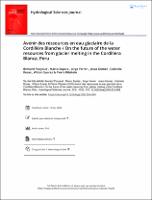On the future of the water resources from glacier melting in the Cordillera Blanca, Peru
Fecha
2005Colecciones
- Artículo científico [171]
Recurso(s) relacionado(s)
https://www.tandfonline.com/doi/abs/10.1623/hysj.2005.50.6.999Resumen
The hydrological data (since 1953) of the Llanganuco basin (87.0 km2, 39% glacierized) show an increase of the glacial melting during the last quarter of the 20th century. These results were supplemented (since the end of 2000) by the data of the small basin of Artesoncocha (8.4 km2, 79% glacierized). The basin runoff is well correlated to the atmospheric temperature derived from the NOAA-NCEP re-analysis above the Cordillera Blanca. At the monthly time scale, the temperature is a good proxy of the glacier melting. The retreat of several glaciers in the Cordillera Blanca has been well documented for 50 years, highlighting an acceleration of the deglaciation in the mid-1970s. The use of these data of various origins permits one to model the behaviour of glaciers, especially the meltwater production, and then to predict their future evolution. The model was calibrated over the 1950–2000 period, thus providing a possible optimistic evolution range (underestimation if the climate change becomes more intense). The forcing of the model by forecasts of the future temperature evolution above the Cordillera Blanca, derived from the regionalization of global climatic models, allows improvement of the estimations only based on past glacial behaviour.
El ítem tiene asociados los siguientes ficheros de licencia:








